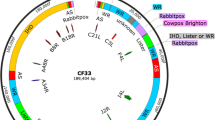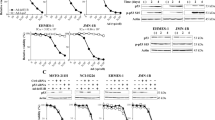Abstract
Approximately 15–30% of human non-small cell lung cancers (NSCLC) carry K-ras mutations, among which point mutations at codon 12 are the most common. This study characterizes the anti-tumor effect of an anti-K-ras ribozyme adenoviral vector (KRbz-ADV; replication-deficient, E1-deleted Ad5 backbone) against NSCLC lines that express the relevant mutation (K-ras codon 12 GGT → GTT; H441 and H1725). KRbz-ADV significantly inhibited tumor cell growth (38–94% reduction by 3H-thymidine uptake) in a time- and dose-dependent manner, but produced minimal growth inhibition on normal epithelial cells, or NSCLC H1650 cells that lack the relevant mutation. The in vivo anti-tumorigenic effect of KRbz-ADV treatment was characterized with cell line xenografts in nu/nu mice. Pre-treatment with KRbz-ADV (10 or 20 p.f.u. per cell) completely abrogated subcutaneous engraftment of H441 (n = 13) or H1725 cells (n = 8), as compared with a 100% tumor take and progressive tumor growth in animals that received untreated tumor cells, or control vector (luciferase-adenovirus/Luc-ADV)-treated tumor cells. Pre-treatment with a mutant anti-K-ras ribozyme adenoviral vector (mutKRbz-ADV), which has the same specificity as KRbz but lacks ribozyme catalytic activity, did not produce an anti-tumorigenic effect. The in vivo effect of KRbz-ADV treatment was further examined by initiating injections (2 × 109 p.f.u.) at 7 days after tumor induction. Pre-existing tumor growth was reduced by 39% by a single intratumoral injection. Repeat injections (three or five KRbz-ADV-intratumoral injections at 2 × 109 p.f.u. every other day) resulted in complete tumor regression in five of seven mice. In contrast, single or multiple injections of control vector Luc-ADV did not significantly alter tumor xenograft outcome. Ribozyme expression was confirmed in H441 cells that demonstrated reduced growth after KRbz-ADV treatment. Reduced growth corresponded to significantly lowered levels of K-ras mRNA, as defined by RT-PCR (51% of untreated level, n = 3) and RNase protection assay (56% of untreated level, n = 4) analyses. Further, 37.5% of KRbz-ADV-treated cells underwent apoptosis, as compared with 11.7%, and 19.0% in untreated and Luc-ADV-treated cultures, respectively. A significantly higher proportion of KRbz-ADV-treated H441 cells (58.2%) underwent apoptosis when maintained under anchor-independent conditions that simulate in vivo tumorigenesis (‘anoikis’). This is the first report that demonstrates that KRbz-ADV can effectively inhibit in vivo tumorigenesis, and produces regression of pre-existing human lung tumor xenografts having the relevant K-ras mutation.
This is a preview of subscription content, access via your institution
Access options
Subscribe to this journal
Receive 12 print issues and online access
$259.00 per year
only $21.58 per issue
Buy this article
- Purchase on Springer Link
- Instant access to full article PDF
Prices may be subject to local taxes which are calculated during checkout




Similar content being viewed by others
References
Martinez AC, Rebollo A . Ras proteins: recent advances and new functions Blood 1999 94: 2971–2980
Zohn IM et al. Rho family proteins and Ras transformation: the RHOad less traveled gets congested Oncogene 1998 17: 1415–1438
Downward J . Ras signaling and apoptosis Curr Opin Genet Dev 1998 8: 49–54
Iran K et al. Mitogenic signaling mediated by oxidants in ras-transformed fibroblasts Science 1997 275: 1649–1652
Rak J et al. Massive programmed cell death in intestinal epithelial cells induced by three-dimensional growth conditions: suppression by mutant c-H-ras oncogene expression J Cell Biol 1995 131: 1587–1598
Okada F et al. Impact of oncogenes in tumor angiogenesis: mutant K-ras up-regulation of vascular endothelial growth factor/vascular permeability factor is necessary, but not sufficient for tumorigenicity of human colorectal carcinoma cells Proc Natl Acad Sci USA 1998 95: 3609–3614
Hahn WC et al. Creation of human tumour cells with defined genetic elements Nature 1999 400: 464–468
Chin L et al. Essential role for oncogenic Ras in tumour maintenance Nature 1999 400: 468–472
Rodenhuis S . RAS oncogenes and human lung cancer. In: Pass HI, Mitchell JB, Johnson DH, Turrisi AT (eds) Lung Cancer: Principles and Practice Lippincott-Raven: Philadelphia 1996 pp ; 73–82
Sun J, Qian Y, Hamilton AD, Sebti SM . Ras CAAX peptidomimetic FTI 276 selectively blocks tumor growth in nude mice of a human lung carcinoma with K-ras mutation and p53 deletion Cancer Res 1995 55: 4243–4247
Zhang WW et al. Retroviral vector-mediated transduction of K-ras antisense RNA into human lung cancer cells inhibits expression of the malignant phenotype Hum Gene Ther 1993 4: 451–460
Georges RN et al. Prevention of orthotopic human lung cancer growth by intratracheal instillation of a retroviral antisense K-ras construct Cancer Res 1993 53: 1743–1746
Cech TR . Self-splicing of group I introns Ann Rev Biochem 1990 59: 543–568
Kijima H et al. Therapeutic applications of ribozymes Pharmacol Ther 1995 68: 247–267
Kashani-Sabet M, Scanlon KJ . Application of ribozymes to cancer gene therapy Cancer Gene Ther 1995 2: 213–223
Ohta Y et al. H-ras ribozyme-mediated alteration of the human melanoma phenotype Ann NY Acad Sci 1994 716: 243–256
Tone T et al. Suppression of EJ cells tumorigenicity In Vivo 1993 7: 471–476
Kashani-Sabet M et al. Suppression of the neoplastic phenotype in vivo by an anti-ras ribozyme Cancer Res 1994 54: 900–902
Kijima H, Bouffard DY, Scanlon KJ . Ribozyme-mediated reversal of human pancreatic carcinoma phenotype. In: Ikehara S, Takahu F, Good R (eds) Proceedings of International Symposium on Bone Marrow Transplantation Springer-Verlag: Tokyo 1996 153–163
Tsuchida T et al. Hammerhead ribozyme specifically inhibits mutant K-ras mRNA of human pancreatic cancer cells Biochem Biophys Res Commun 1998 253: 368–373
Tong AW, Zhang YA, Nemunaitis J, Mues G . K-ras ribozyme for lung cancer. In: Scanlon KJ (ed) Therapeutic Application of Ribozymes: Methods in Molecular Medicine vol. 11: Humana Press: Clifton, NJ 1998 pp 209–222
Zhang YA et al. In vitro suppression of human non-small cell lung cancer (NSCLC) cell growth by an anti-K-ras ribozyme FASEB J 1996 10: 6 (Abstr. 1409)
Cantor GH et al. Ribozyme cleaves rex/tax mRNA and inhibits bovine leukemia virus expression Proc Natl Acad Sci USA 1993 90: 10932–10936
Kashani-Sabet M et al. Reversal of the malignant phenotype by an anti-ras ribozyme Antisense Res Dev 1992 2: 3–15
Yamazaki H et al. Inhibition of tumor growth by ribozyme-mediated suppression of aberrant epidermal growth factor receptor gene expression J Natl Cancer Inst 1998 90: 581–587
Irie A et al. Therapeutic efficacy of an adenovirus-mediated anti-H-ras ribozyme in experimental bladder cancer Antisense Nucleic Acid Drug Dev 1999 9: 341–349
Marches R et al. Tumor dormancy and cell signalling III: role of hypercrosslinking of IgM and CD40 on the induction of cell cycle arrest and apoptosis in B lymphoma cells Ther Immunol 1995 2: 125–136
Lecoeur H, Ledru E, Prevost MC, Gougeon ML . Strategies for phenotyping apoptotic peripheral human lymphocytes comparing ISNT, annexin-V and 7-AAD cytofluorometric staining methods J Immunol Methods 1997 209: 111–123
Kung HF et al. Reversal of transformed phenotype by monoclonal antibodies against Ha-ras p21 proteins Exp Cell Res 1986 162: 363–371
Cochet O et al. Intracellular expression of an antibody fragment-neutralizing p21 Ras promotes tumor regression Cancer Res 1998 58: 1170–1176
Nemunaitis J et al. Prognostic value of K-ras mutations, Ras oncoprotein and c-erb B-2 oncoprotein expression in adenocarcinoma of the lung Am J Clin Oncol 1998 21: 155–160
Kozarsky KF, Wilson JM . Gene therapy: adenovirus vectors Curr Opin Genet Dev 1993 3: 499–503
Mahgoub N et al. In vitro and in vivo effects of a farnesyltransferase inhibitor on Nf1-deficient hematopoietic cells Blood 1999 94: 2469–2476
Sun J, Qian Y, Hamilton AD, Sebti SM . Both farnesyltransferase and geranylgeranyltransferase I inhibitors are required for inhibition of oncogenic K-ras prenylation but each alone is sufficient to suppress human tumor growth in nude mouse xenografts Oncogene 1998 16: 1467–1473
Rodenhuis S . Ras and human tumors Semin Cancer Bio 1992 3: 241–247
Tong AW, Zhang YA, Bouffard DY, Nemunaitis J . The use of ribozymes for gene therapy of lung cancer. In: Kashani-Sabet M, Scanlon KJ (eds) Ribozyme in Gene Therapy of Cancer RG Landes: Georgetown, TX 1998 pp 151–164
Zabner J et al. Safety and efficacy of repetitive adenovirus-mediated transfer of CFTR cDNA to airway epithelia of primates and cotton rats Nat Genet 1994 6: 75–83
Dong JY et al. Systematic analysis of repeated gene delivery into animal lungs with a recombinant adenovirus vector Hum Gene Ther 1996 7: 319–331
Zhang WW et al. Safety evaluation of Ad5CMV-p53 in vitro and in vivo Hum Gene Ther 1995 6: 155–164
Nechers L, Whitesell L, Rosolen A, Geselowitz DA . Antisense inhibition of oncogene expression Crit Rev Oncogen 1992 3: 175–231
Aoki K et al. Suppression of Ki-ras p21 levels leading to growth inhibition of pancreatic cancer cell lines with Ki-ras mutation but not those without Ki-ras mutation Mol Carcinogen 1997 20: 251–258
Leonidas A et al. Hammerhead ribozymes targeted to the FBN1 mRNA can discriminate a single base mismatch between ribozyme and target Biochem Biophys Res Commun 1998 249: 804–810
Ward RL et al. Activation of the K-ras oncogene in colorectal neoplasms is associated with decreased apoptosis Cancer 1997 79: 1106–1113
Kerbel RS, Viloria-Petit A, Okada FTI, Rak J . Establishing a link between oncogenes and tumor angiogenesis Mol Med 1998 4: 286–295
Robles A et al. Reduced skin tumor development in cyclin D1-deficient mice highlights the oncogenic Ras pathway in vivo Genes Dev 1998 12: 2469–2474
Bishoff JR et al. An adenovirus mutant that replicates selectively in p53-deficient human tumor cells Science 1996 274: 373–376
Mtistudomi T et al. p53 gene mutations in non-small-cell lung cancer cell lines and their correlation with the presence of ras mutations and clinical features Oncogene 1992 7: 171–180
Phelps RM et al. NCI-Navy medical oncology branch cell line data base J Cell Biochem 1996 24: (Suppl.) 32–91
Tsuchida T et al. Adenovirus-mediated anti-K-ras ribozyme induces apoptosis and growth suppression of human pancreatic carcinoma Cancer Gene Ther 2000 7: 373–383
Becker TC et al. Use of recombinant adenovirus for metabolic engineering of mammalian cells Meth Cell Biol 1994 43: 161–189
Zhang YA, Nemunaitis J, Tong AW . Anti-K-ras ribozyme adenoviral vector for gene therapy of non-small cell lung cancer. In: Walther W, Stein U (eds) Gene Therapy of Cancer: Methods and Protocols: Methods in Molecular Medicine vol. 35: Humana Press: Totowa, NJ 1999 pp 257–267
Feng M et al. Neoplastic reversion accomplished by high efficiency adenoviral-mediated delivery of an anti-ras ribozyme Cancer Res 1995 55: 2024–2028
Toloza EM et al. In vivo cancer gene therapy with a recombinant interleukin-2 adenovirus vector Cancer Gene Ther 1996 3: 11–17
Heike Y et al. Interleukin-2 gene transduction into freshly isolated lung adenocarcinoma cells with adenoviral vectors Hum Gene Ther 1997 8: 1–14
Tong AW et al. Anti-CD40 antibody binding modulates human multiple myeloma clonogenicity in vitro Blood 1994 84: 3026–3033
Logel J et al. Synthesis of cRNA probes from PCR-generated DNA BioTechniques 1992 13: 604–610
Lebowitz PF et al. Farnesyl transferase inhibitors induce apoptosis of ras-transformed cells denied substratum attachment Cancer Res 1997 57: 708–713
Acknowledgements
This work was supported in part by the Mary Crowley Research Foundation, the Robert A Schanbaum Memorial Fund for Cancer Research, and by a Berlex Biosciences Cancer Research grant. The authors thank Guido A Ordonez of the Immunology Laboratory, Baylor University Medical Center, for his assistance on flow cytometric analysis of apoptosis. We thank Joseph M Lawson and Beverly Peters, Baylor University Medical Center, for their assistance with preparation of the figures.
Author information
Authors and Affiliations
Rights and permissions
About this article
Cite this article
Zhang, YA., Nemunaitis, J., Scanlon, K. et al. Anti-tumorigenic effect of a K-ras ribozyme against human lung cancer cell line heterotransplants in nude mice. Gene Ther 7, 2041–2050 (2000). https://doi.org/10.1038/sj.gt.3301331
Received:
Accepted:
Published:
Issue Date:
DOI: https://doi.org/10.1038/sj.gt.3301331
Keywords
This article is cited by
-
Hairpin Ribozyme Genes Curtail Alcohol Drinking: from Rational Design to in vivo Effects in the Rat
Molecular Therapy - Nucleic Acids (2016)
-
RAS oncogenes: weaving a tumorigenic web
Nature Reviews Cancer (2011)
-
MicroRNA profile analysis of human prostate cancers
Cancer Gene Therapy (2009)
-
Ras oncogenes: split personalities
Nature Reviews Molecular Cell Biology (2008)
-
Pharmacokinetic and pharmacodynamic study of intratumoral injection of an adenovirus encoding endostatin in patients with advanced tumors
Gene Therapy (2008)



